Jamba: A Hybrid Transformer-Mamba Language Model
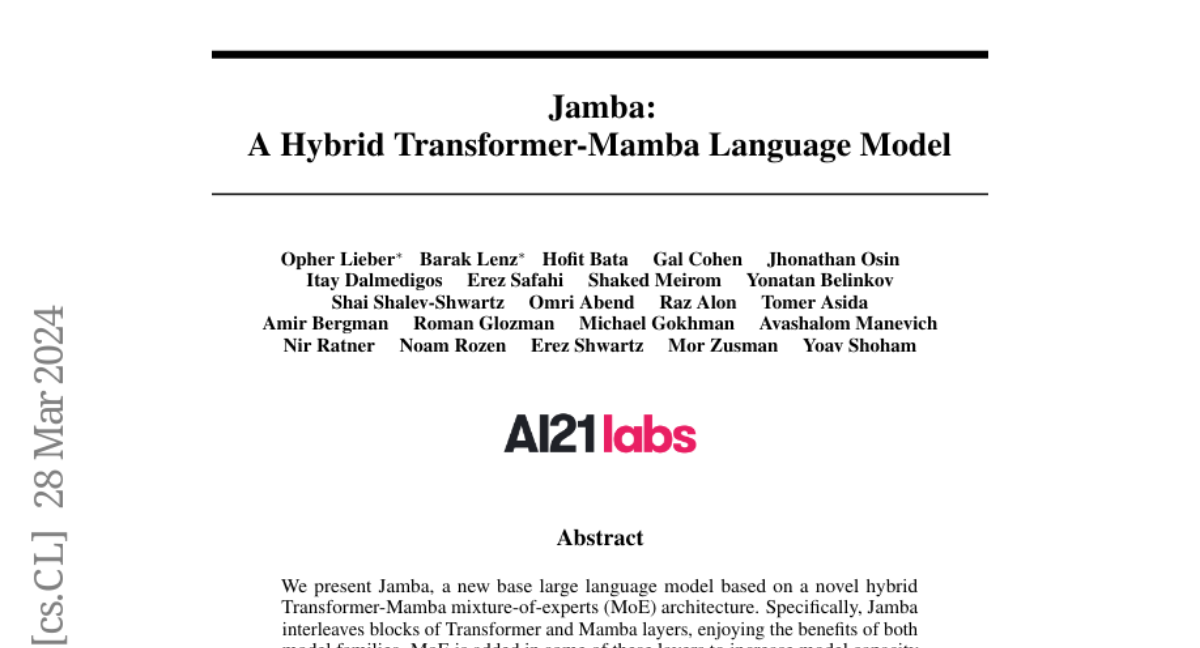
We present Jamba, a new base large language model based on a novel hybrid Transformer-Mamba mixture-of-experts (MoE) architecture. Specifically, Jamba interleaves blocks of Transformer and Mamba layers, enjoying the benefits of both model families. MoE is added in some of these layers to increase model capacity while keeping active parameter usage manageable. This flexible architecture allows resource- and objective-specific configurations. In the particular configuration we have implemented, we end up with a powerful model that fits in a single 80GB GPU. Built at large scale, Jamba provides high throughput and small memory footprint compared to vanilla Transformers, and at the same time state-of-the-art performance on standard language model benchmarks and long-context evaluations. Remarkably, the model presents strong results for up to 256K tokens context length. We study various architectural decisions, such as how to combine Transformer and Mamba layers, and how to mix experts, and show that some of them are crucial in large scale modeling. We also describe several interesting properties of these architectures which the training and evaluation of Jamba have revealed, and plan to release checkpoints from various ablation runs, to encourage further exploration of this novel architecture. We make the weights of our implementation of Jamba publicly available under a permissive license.
Transformer-Lite: High-efficiency Deployment of Large Language Models on Mobile Phone GPUs
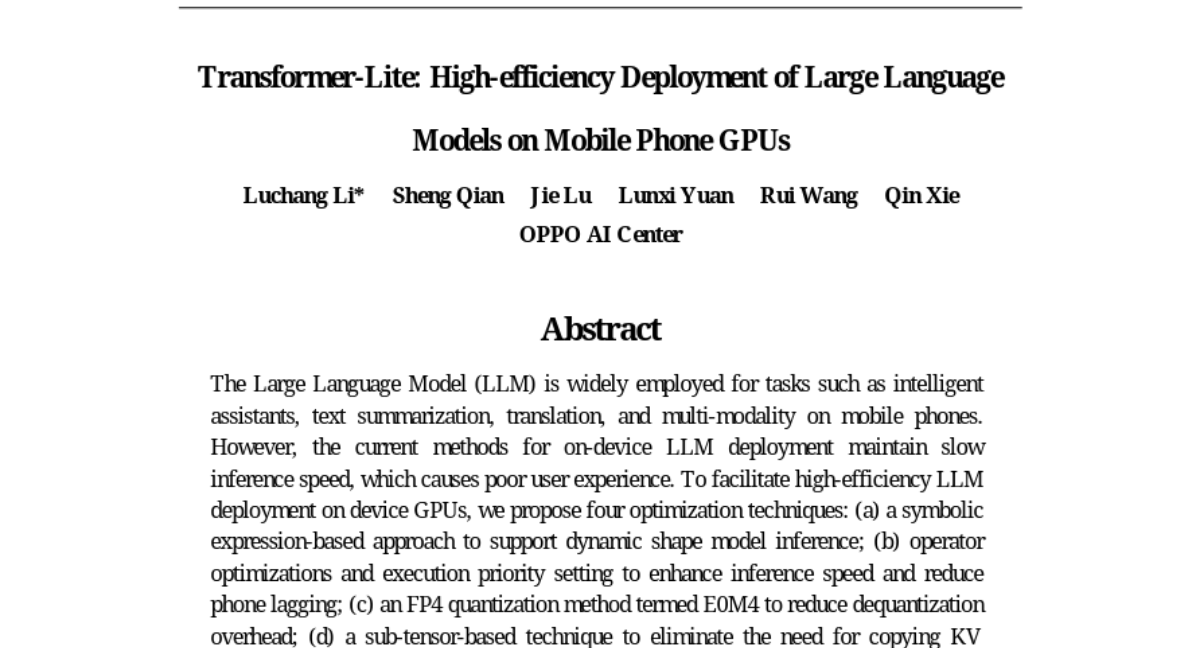
The Large Language Model (LLM) is widely employed for tasks such as intelligent assistants, text summarization, translation, and multi-modality on mobile phones. However, the current methods for on-device LLM deployment maintain slow inference speed, which causes poor user experience. To facilitate high-efficiency LLM deployment on device GPUs, we propose four optimization techniques: (a) a symbolic expression-based approach to support dynamic shape model inference; (b) operator optimizations and execution priority setting to enhance inference speed and reduce phone lagging; (c) an FP4 quantization method termed M0E4 to reduce dequantization overhead; (d) a sub-tensor-based technique to eliminate the need for copying KV cache after LLM inference. Furthermore, we implement these methods in our mobile inference engine, Transformer-Lite, which is compatible with both Qualcomm and MTK processors. We evaluated Transformer-Lite's performance using LLMs with varied architectures and parameters ranging from 2B to 14B. Specifically, we achieved prefill and decoding speeds of 121 token/s and 14 token/s for ChatGLM2 6B, and 330 token/s and 30 token/s for smaller Gemma 2B, respectively. Compared with CPU-based FastLLM and GPU-based MLC-LLM, our engine attains over 10x speedup for the prefill speed and 2~3x speedup for the decoding speed.
Gecko: Versatile Text Embeddings Distilled from Large Language Models
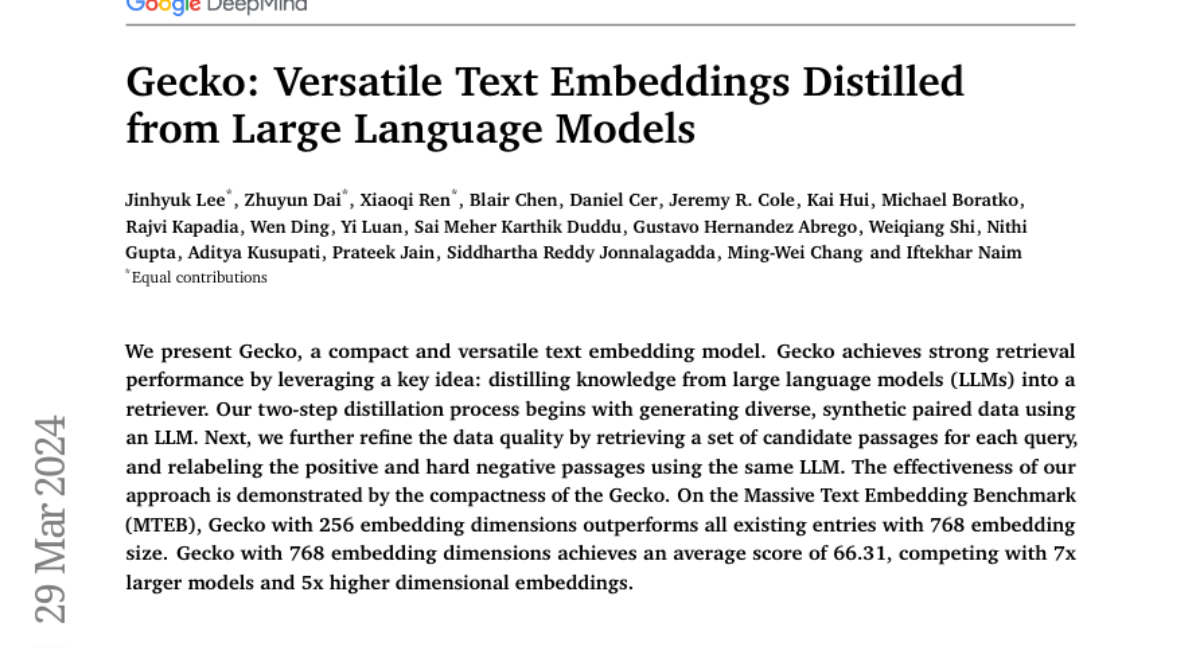
We present Gecko, a compact and versatile text embedding model. Gecko achieves strong retrieval performance by leveraging a key idea: distilling knowledge from large language models (LLMs) into a retriever. Our two-step distillation process begins with generating diverse, synthetic paired data using an LLM. Next, we further refine the data quality by retrieving a set of candidate passages for each query, and relabeling the positive and hard negative passages using the same LLM. The effectiveness of our approach is demonstrated by the compactness of the Gecko. On the Massive Text Embedding Benchmark (MTEB), Gecko with 256 embedding dimensions outperforms all existing entries with 768 embedding size. Gecko with 768 embedding dimensions achieves an average score of 66.31, competing with 7x larger models and 5x higher dimensional embeddings.
Localizing Paragraph Memorization in Language Models
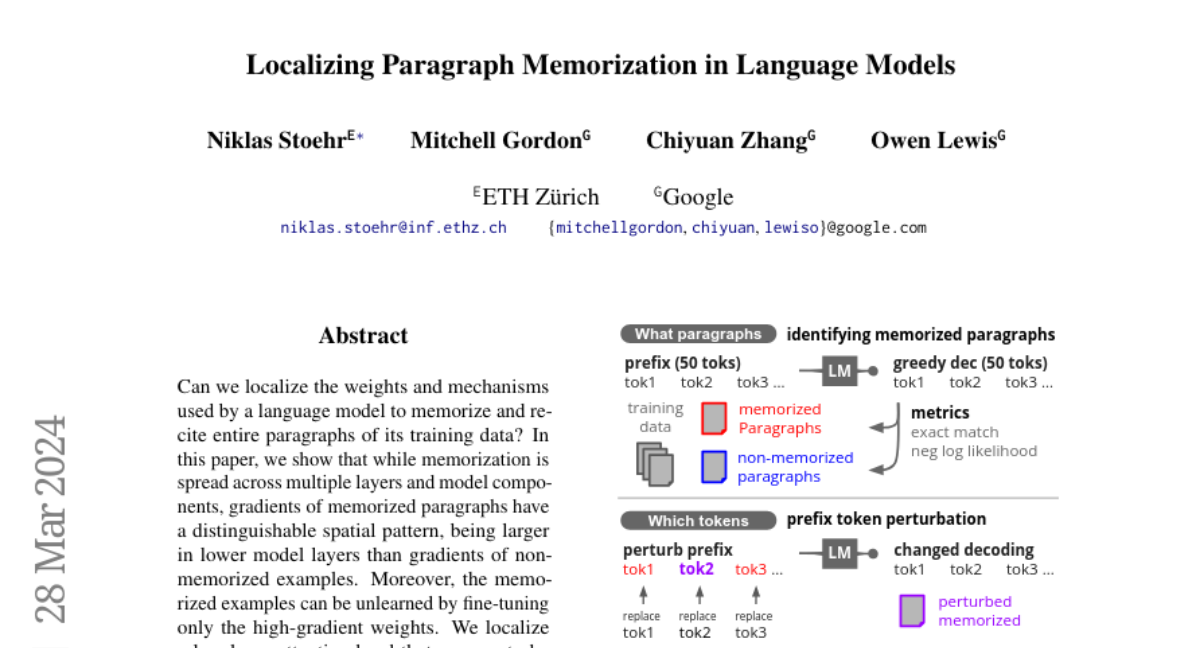
Can we localize the weights and mechanisms used by a language model to memorize and recite entire paragraphs of its training data? In this paper, we show that while memorization is spread across multiple layers and model components, gradients of memorized paragraphs have a distinguishable spatial pattern, being larger in lower model layers than gradients of non-memorized examples. Moreover, the memorized examples can be unlearned by fine-tuning only the high-gradient weights. We localize a low-layer attention head that appears to be especially involved in paragraph memorization. This head is predominantly focusing its attention on distinctive, rare tokens that are least frequent in a corpus-level unigram distribution. Next, we study how localized memorization is across the tokens in the prefix by perturbing tokens and measuring the caused change in the decoding. A few distinctive tokens early in a prefix can often corrupt the entire continuation. Overall, memorized continuations are not only harder to unlearn, but also to corrupt than non-memorized ones.
InstantSplat: Unbounded Sparse-view Pose-free Gaussian Splatting in 40 Seconds
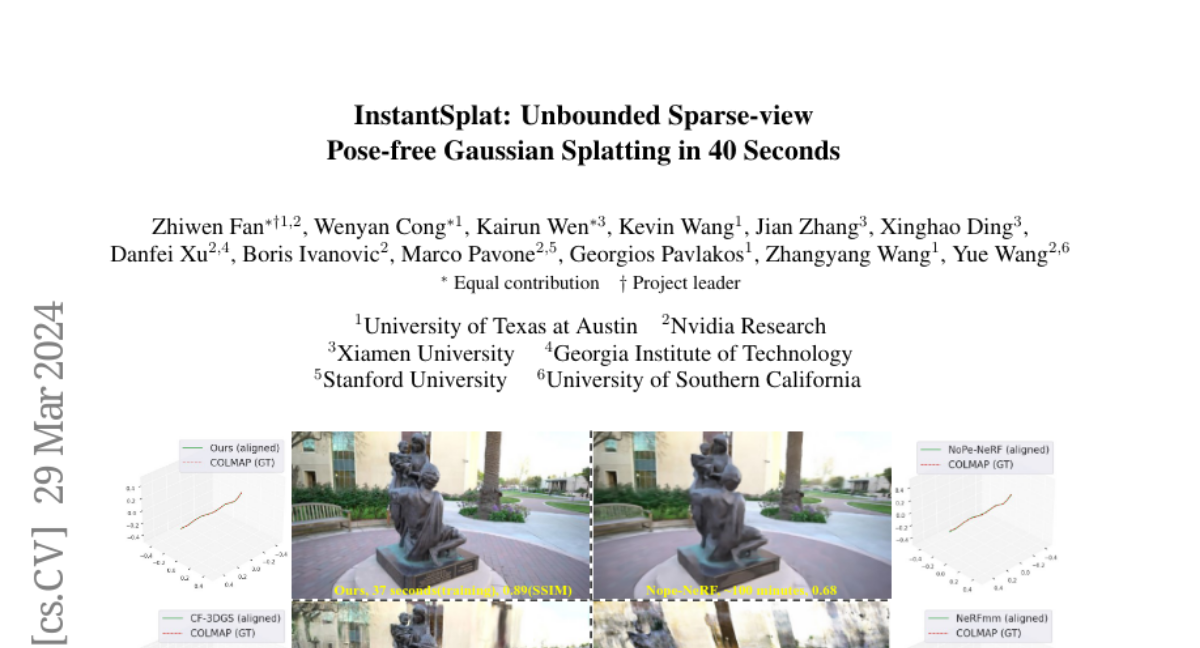
While novel view synthesis (NVS) has made substantial progress in 3D computer vision, it typically requires an initial estimation of camera intrinsics and extrinsics from dense viewpoints. This pre-processing is usually conducted via a Structure-from-Motion (SfM) pipeline, a procedure that can be slow and unreliable, particularly in sparse-view scenarios with insufficient matched features for accurate reconstruction. In this work, we integrate the strengths of point-based representations (e.g., 3D Gaussian Splatting, 3D-GS) with end-to-end dense stereo models (DUSt3R) to tackle the complex yet unresolved issues in NVS under unconstrained settings, which encompasses pose-free and sparse view challenges. Our framework, InstantSplat, unifies dense stereo priors with 3D-GS to build 3D Gaussians of large-scale scenes from sparseview & pose-free images in less than 1 minute. Specifically, InstantSplat comprises a Coarse Geometric Initialization (CGI) module that swiftly establishes a preliminary scene structure and camera parameters across all training views, utilizing globally-aligned 3D point maps derived from a pre-trained dense stereo pipeline. This is followed by the Fast 3D-Gaussian Optimization (F-3DGO) module, which jointly optimizes the 3D Gaussian attributes and the initialized poses with pose regularization. Experiments conducted on the large-scale outdoor Tanks & Temples datasets demonstrate that InstantSplat significantly improves SSIM (by 32%) while concurrently reducing Absolute Trajectory Error (ATE) by 80%. These establish InstantSplat as a viable solution for scenarios involving posefree and sparse-view conditions. Project page: instantsplat.github.io.
Unsolvable Problem Detection: Evaluating Trustworthiness of Vision Language Models
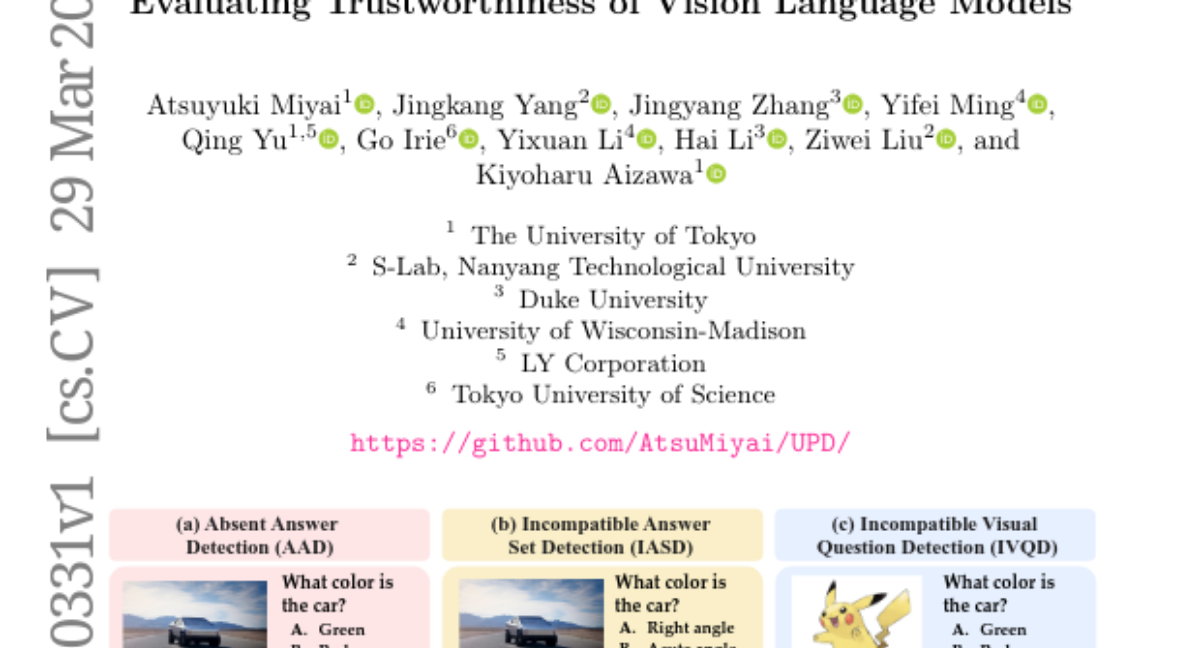
This paper introduces a novel and significant challenge for Vision Language Models (VLMs), termed Unsolvable Problem Detection (UPD). UPD examines the VLM's ability to withhold answers when faced with unsolvable problems in the context of Visual Question Answering (VQA) tasks. UPD encompasses three distinct settings: Absent Answer Detection (AAD), Incompatible Answer Set Detection (IASD), and Incompatible Visual Question Detection (IVQD). To deeply investigate the UPD problem, extensive experiments indicate that most VLMs, including GPT-4V and LLaVA-Next-34B, struggle with our benchmarks to varying extents, highlighting significant room for the improvements. To address UPD, we explore both training-free and training-based solutions, offering new insights into their effectiveness and limitations. We hope our insights, together with future efforts within the proposed UPD settings, will enhance the broader understanding and development of more practical and reliable VLMs.
ReALM: Reference Resolution As Language Modeling
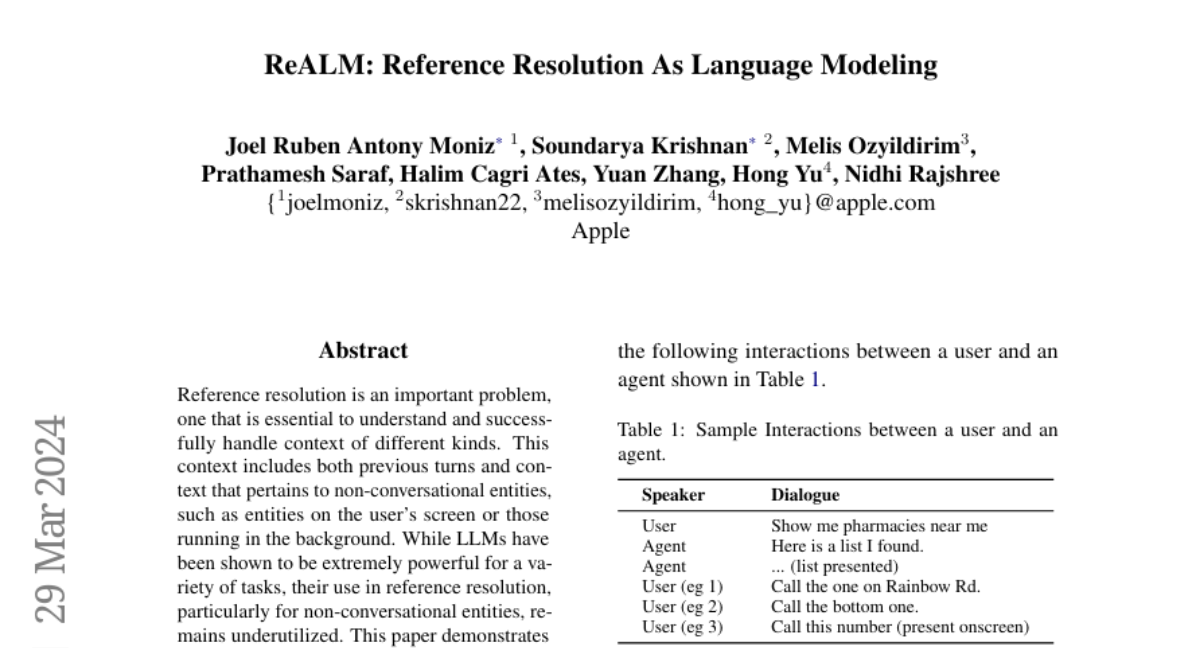
Reference resolution is an important problem, one that is essential to understand and successfully handle context of different kinds. This context includes both previous turns and context that pertains to non-conversational entities, such as entities on the user's screen or those running in the background. While LLMs have been shown to be extremely powerful for a variety of tasks, their use in reference resolution, particularly for non-conversational entities, remains underutilized. This paper demonstrates how LLMs can be used to create an extremely effective system to resolve references of various types, by showing how reference resolution can be converted into a language modeling problem, despite involving forms of entities like those on screen that are not traditionally conducive to being reduced to a text-only modality. We demonstrate large improvements over an existing system with similar functionality across different types of references, with our smallest model obtaining absolute gains of over 5% for on-screen references. We also benchmark against GPT-3.5 and GPT-4, with our smallest model achieving performance comparable to that of GPT-4, and our larger models substantially outperforming it.
Snap-it, Tap-it, Splat-it: Tactile-Informed 3D Gaussian Splatting for Reconstructing Challenging Surfaces

Touch and vision go hand in hand, mutually enhancing our ability to understand the world. From a research perspective, the problem of mixing touch and vision is underexplored and presents interesting challenges. To this end, we propose Tactile-Informed 3DGS, a novel approach that incorporates touch data (local depth maps) with multi-view vision data to achieve surface reconstruction and novel view synthesis. Our method optimises 3D Gaussian primitives to accurately model the object's geometry at points of contact. By creating a framework that decreases the transmittance at touch locations, we achieve a refined surface reconstruction, ensuring a uniformly smooth depth map. Touch is particularly useful when considering non-Lambertian objects (e.g. shiny or reflective surfaces) since contemporary methods tend to fail to reconstruct with fidelity specular highlights. By combining vision and tactile sensing, we achieve more accurate geometry reconstructions with fewer images than prior methods. We conduct evaluation on objects with glossy and reflective surfaces and demonstrate the effectiveness of our approach, offering significant improvements in reconstruction quality.
MambaMixer: Efficient Selective State Space Models with Dual Token and Channel Selection
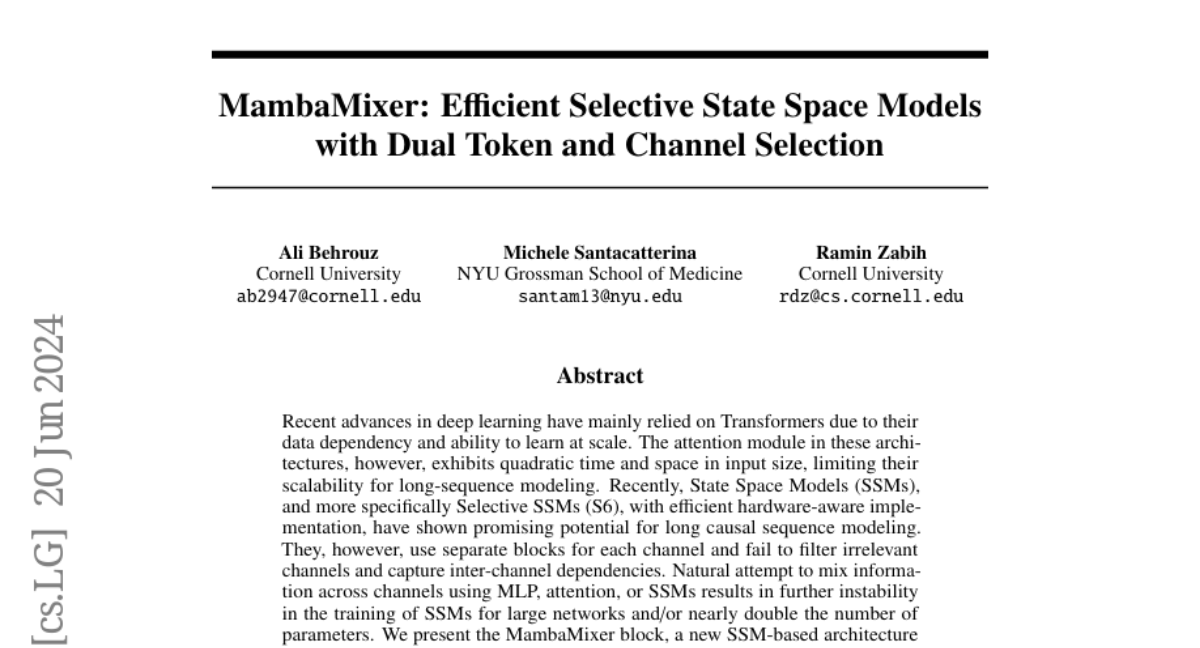
Recent advances in deep learning have mainly relied on Transformers due to their data dependency and ability to learn at scale. The attention module in these architectures, however, exhibits quadratic time and space in input size, limiting their scalability for long-sequence modeling. Despite recent attempts to design efficient and effective architecture backbone for multi-dimensional data, such as images and multivariate time series, existing models are either data independent, or fail to allow inter- and intra-dimension communication. Recently, State Space Models (SSMs), and more specifically Selective State Space Models, with efficient hardware-aware implementation, have shown promising potential for long sequence modeling. Motivated by the success of SSMs, we present MambaMixer, a new architecture with data-dependent weights that uses a dual selection mechanism across tokens and channels, called Selective Token and Channel Mixer. MambaMixer connects selective mixers using a weighted averaging mechanism, allowing layers to have direct access to early features. As a proof of concept, we design Vision MambaMixer (ViM2) and Time Series MambaMixer (TSM2) architectures based on the MambaMixer block and explore their performance in various vision and time series forecasting tasks. Our results underline the importance of selective mixing across both tokens and channels. In ImageNet classification, object detection, and semantic segmentation tasks, ViM2 achieves competitive performance with well-established vision models and outperforms SSM-based vision models. In time series forecasting, TSM2 achieves outstanding performance compared to state-of-the-art methods while demonstrating significantly improved computational cost. These results show that while Transformers, cross-channel attention, and MLPs are sufficient for good performance in time series forecasting, neither is necessary.
DiJiang: Efficient Large Language Models through Compact Kernelization

In an effort to reduce the computational load of Transformers, research on linear attention has gained significant momentum. However, the improvement strategies for attention mechanisms typically necessitate extensive retraining, which is impractical for large language models with a vast array of parameters. In this paper, we present DiJiang, a novel Frequency Domain Kernelization approach that enables the transformation of a pre-trained vanilla Transformer into a linear complexity model with little training costs. By employing a weighted Quasi-Monte Carlo method for sampling, the proposed approach theoretically offers superior approximation efficiency. To further reduce the training computational complexity, our kernelization is based on Discrete Cosine Transform (DCT) operations. Extensive experiments demonstrate that the proposed method achieves comparable performance to the original Transformer, but with significantly reduced training costs and much faster inference speeds. Our DiJiang-7B achieves comparable performance with LLaMA2-7B on various benchmark while requires only about 1/50 training cost. Code is available at https://github.com/YuchuanTian/DiJiang.